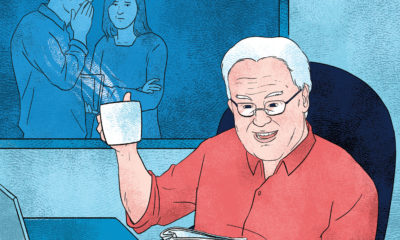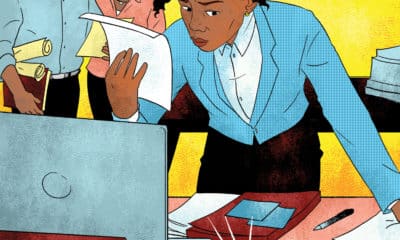
The Case of the High Rise Horror
A sign company is caught in a costly quandary as disaster strikes during installation.
Published
2 years agoon
THE NEW SIGN for Tighton & Massiff, Bayville’s largest law firm, was huge — 4-ft. channel letters on a 48-ft. raceway along with an 8-ft. circular “TM” logo. The sign’s distinctive design and massive size had been perfectly proportioned for the top of 222 Bayshore Drive, a prominent 22-story, 275-ft.-tall skyscraper built in 1984.
International Sign, Bayville’s oldest and most trusted sign contractor, who had been hired for the sign’s fabrication and erection, planned to install the configuration in three sections. The round logo would be hoisted in one piece. The channel letters would arrive on site in two halves before being joined on the ground, then lifted into place.
ABOUT REAL DEAL
Real Deal scenarios are inspired by true stories, but are changed to sharpen the dilemmas involved and should not be confused with real people or places. Responses are peer-sourced opinions and are NOT a substitute for professional legal advice. Please contact your attorney if you any questions about an employee or customer situation in your own business.
ABOUT THE AUTHOR
LAWRIN ROSEN is the president of ARTfx (Bloomfield, CT). Email him at lawrin@artfxsigns.com
When The Bayville Herald published news of Tighton & Massiff’s upcoming move into six floors of 222 Bayshore, Ursula Bartholomew, International’s ace sales representative, went after and landed the sign work like a heat-seeking missile. She moved swiftly on a tip from her friend, Gloria Soote, a principal at the law firm. Gloria informed Ursula that the potential for a large-scale sign on the building was a prime motivator in the client’s space selection.
Excelon Engineering, who handled most of the area’s more complex engineering projects, designed the attachments for the sign: eight ⅝-in. stainless steel rods for the circular logo and 12 of the same rods for the raceway (four ⅝-in. rods connecting three individual steel mounting plates). The rods were designed to pass from the sign sections through gasket-lined drill holes in the building’s granite-curtain wall, and then through the webs of the building’s inner structural-steel I-beams.
AdvertisementGuy Boyman, International Sign’s installation foreman, was concerned about the project from the beginning. He and Ursula disagreed over multiple difficulties in the job logistics. He cautioned Ursula along with International’s top brass that 222 Bayshore’s granite-curtain wall was unusually fragile. Potential problems during the drilling process might initiate chipping. Worse, if any of the stainless rods contacted any granite-hole edges, the pressure could cause cracking.
For the installation, International Sign proceeded with utmost caution. They rented a modular 60-ft. power swing-stage that was inspected by trained professionals for the technicians. A 334-ft. industrial crane was set up to lift the components. Due to the scale of the job and enormity of the equipment required, the Bayville Police Department and the building management agreed on a weekend installation. For the premium time and resources required, International Sign had to factor approximately $40,000 of extra costs into the installation price.
Day one of the installation proceeded smoothly. That Saturday, Guy relaxed for the first time in weeks after the installers drilled without a hitch the 16th and final hole as the Excelon experts had specified. Immediately following, the I-beam drilling and installation of the stainless-steel rods progressed uneventfully. With all site work successfully accomplished, the International Sign installation team was fully prepared for a Sunday sign installation.
Like the preparation work on day one, the installation of the sign components proceeded without incident … until the final bolt was tightened. As fate would have it, the last turn of the wrench imposed too much pressure between the raceway and the building, triggering two 6-ft. x 4-ft. x 2-in.-thick granite tiles to crack horizontally through their centers. In an instant, the mounting elation felt by Guy and his installation professionals deteriorated, leaving in its place complete horror. With mouths agape, the four men left the site for the first of many sleepless nights.
Although the thin cracks which had completely pierced the 2-in.-thick tiles could not be seen from the ground, torrential rains later that Sunday seeped through the cracks and into the law firm’s brand-new office space, leaving Tighton & Massiff’s expensive new carpeting a watery mess. The principals of the firm loved the sign, but were immediately prepared to sue the sign company over the cracked granite unless a clear solution solved the disastrous situation.
On Monday morning, following the fateful installation, frantic International Sign officials called and emailed companies throughout the greater Bayville area to seek solutions. However, they encountered two big problems:
- The quarry that produced the original pink granite tiles, indigenous to one area of the United States, had been closed for years and the last of the tiles was nowhere to be found.
- The masonry company that originally installed the 300-lb. tiles insisted the sign be removed before they could begin work. Additionally, they wouldn’t guarantee the perfect integrity of the repair, nor would they offer a firm quotation. Due to the uniqueness of the problem, they stated all work would be billed strictly on a time-and-material basis.
By close of Monday, resourcefulness gave way to dread and resignation as Ursula Bartholomew and the higher-ups at International Sign sat around the company conference table with blank stares, completely lost for words. Ursula thought of offering a conciliatory pep talk, but Guy Boyman’s icy stare unnerved her. In 40 years of company history, this unfortunate situation was a first.
AdvertisementThe Big Questions
- What action(s) would you consider in this dilemma?
- Any corrective direction appears to be extremely costly. What would you prioritize?
D. Pat R.
Sykesville, PA
Profit on a job is not worth losing your customer or your reputation. Take down the sign, remove a border of granite around and behind the sign, have new granite installed and reinstall the sign. The contrasting granite will frame the new sign and look like it was designed that way. Everyone will see that you did the right thing and corrected your mistake. This will be seen by every potential customer in town, resulting in continued success. Consider it good marketing. Everyone makes mistakes; it’s what you do after the mistake that counts.
Narses R.
San Juan, PR
Being that the crack cannot be seen from the ground and the [client is] happy with the sign, why not just fill the crack with a clear (colorless) resin or silicone making it waterproof? As far as the carpeting [goes], I guess you’ll have to take the loss.
Paul K.
Elk Grove Village, IL
With litigation pending, stay in communication with the client. There is nothing worse than radio silence in situations like this. Maintain transparency with your client and respond to questions they have. Be professional. Your reaction to this potential disaster could impact your reputation and future projects. Immediately take lots of photographs of the damages and get that section of damaged tiles covered with tarps to prevent further damage. Demonstrate to your client your willingness to act. Contact your insurance agent and explain the situation. Conduct a meeting with the client [and] the masonry repair company … to discuss the pitfalls with the repairs. Again, demonstrate to your client your willingness to act. Your client needs to understand that the repairs cannot be guaranteed. Any way you look at it, losses will occur — or at least less profit.
AdvertisementAndy
Wausau, WI
A sign company has to evaluate all situations before a contract has been signed to start a project. In this case a waiver was needed to inform the client of possible problems with the granite cracking and that the sign company would not be responsible for such. If they would like to proceed, they can sign the waiver and the sign company would be as careful as they can but yet not responsible. That has to be the first step to avoid any issues that can occur. If this process didn’t take place, the next step is to look to granite professionals. Many times there are adhesives today that can not only prevent any leaking of moisture, but also prevent further cracking. You might find that the granite professional might also have another solution. Since you cannot see the crack from below, this could be the best solution without breaking the bank or being in a legal battle.
Alex P.
Chicago, IL
It’s unfortunate but with projects like this … the big risk came into play here and won, and the most important course of action here is to make the situation right no matter what the costs are, which means possibly breaking even or losing a lot of money. It’s a part of business and happens to all of us from time to time. The possible lawsuit would cost way more than fixing this mess — and offer to pay to have the carpet cleaned as well.
Joe G.
Portland, OR
In the initial survey, the installation company‘s install foreman had concerns with the granite tiles. This should have been added into the installation contract exemption of any cost or damages caused by the installation of the new sign. One of the hardest things to say in this industry is “no,” especially on high-profile installations. Without anything in the contract addressing these tiles, I would say they’re going to have to bite the bullet and just get it fixed, learn from this lesson and move on.
What’s the Brain Squad?
If you’re the owner or top manager of a U.S. sign business, you’re invited to join the Signs of the Times Brain Squad. Take one five-minute quiz a month, and you’ll be featured prominently in this magazine, and make your voice heard on key issues affecting the sign business. Sign up here.
Lawrin Rosen founded ARTfx Signs (Bloomfield, CT) in 1983. The company focuses on artistically based production of signs, awnings, architectural elements and corporate art. Contact Lawrin at lawrin@artfxsigns.com.

SPONSORED VIDEO
Introducing the Sign Industry Podcast
The Sign Industry Podcast is a platform for every sign person out there — from the old-timers who bent neon and hand-lettered boats to those venturing into new technologies — we want to get their stories out for everyone to hear. Come join us and listen to stories, learn tricks or techniques, and get insights of what’s to come. We are the world’s second oldest profession. The folks who started the world’s oldest profession needed a sign.
You may like

6 Sports Venue Signs Deserving a Standing Ovation

Hiring Practices and Roles for Women in Sign Companies

Avery Dennison Adopts Mimaki Printer for Traffic Sign Print System
Subscribe

Bulletins
Get the most important news and business ideas from Signs of the Times magazine's news bulletin.
Most Popular
-

 Tip Sheet3 days ago
Tip Sheet3 days agoAlways Brand Yourself and Wear Fewer Hats — Two of April’s Sign Tips
-

 Business Management1 week ago
Business Management1 week agoWhen Should Sign Companies Hire Salespeople or Fire Customers?
-

 Women in Signs2 weeks ago
Women in Signs2 weeks ago2024 Women in Signs Award Winners Excel in Diverse Roles
-

 Real Deal4 days ago
Real Deal4 days agoA Woman Sign Company Owner Confronts a Sexist Wholesaler
-

 Editor's Note1 week ago
Editor's Note1 week agoWhy We Still Need the Women in Signs Award
-

 Line Time2 weeks ago
Line Time2 weeks agoOne Less Thing to Do for Sign Customers
-

 Product Buying + Technology1 week ago
Product Buying + Technology1 week agoADA Signs and More Uses for Engraving Machines
-

 Women in Signs4 days ago
Women in Signs4 days ago2024 Women in Signs: Megan Bradley











